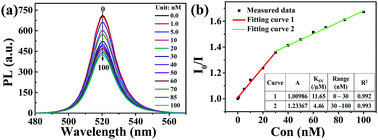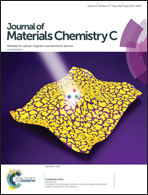All-inorganic CsPbBr3 perovskite quantum dots as a photoluminescent probe for ultrasensitive Cu2+ detection†
Abstract
Pollution triggered by highly toxic heavy metal ions has become a worldwide issue of concern, and has aroused increasing research interest, but it is still a challenge to carry out its trace detection in the organic phase using inorganic fluorescent colloidal nanocrystals (NCs). Herein, we report fully inorganic CsPbBr3 perovskite quantum dots (PQDs), which were synthesized via a hot-injection method, as a fluorescent probe for the selective detection of copper ions in hexane. The photoluminescence (PL) intensity of CsPbBr3 PQDs is significantly quenched within several seconds after the addition of Cu2+ due to effective electron transfer from the PQDs to the added Cu2+, which is experimentally verified via analyzing absorption spectra and PL decay lifetime. The sensor, in turn-off mode, has a detection range from 0 to 100 nM with a limit of detection (LOD) as low as 0.1 nM, indicating great potential for practical applications. This study paves the way for PQD-based fluorescent probes for heavy metal detection in the organic phase.

- This article is part of the themed collection: Industry R&D collection


 Please wait while we load your content...
Please wait while we load your content...